2017 Reflections

A view from the hilltop—above the Cardoner River in Manresa, Spain—where Ignatius of Loyola experienced “the eyes of his understanding” beginning to open, where he became aware of “many things, both spiritual things and matters of faith and learning,” and where “everything seemed new to him.”
DAY 3: June 22 Moments of Conversion
DAY 4: June 23 Pilgrimage and Discernment
DAY 5: June 24 Spiritual Development
DAY 6: June 25 A Living Example In Manresa
DAY 7: June 26 Encountering the World in Barcelona
DAY 8: June 27 The Foundation of the Society
DAY 9: June 28th The Early Governance of the Society
DAY 1: JUNE 20 IBERIAN ROOTS
Madrid, Arevalo, Burgos, Azpeitia
Arriving: Today was a day of arriving and setting the stage for the life of young Ignatius and the context in which he was born and lived. We arrived in Madrid at 6:30am and traveled to Arévelo, where Ignatius spent 13 formative years serving as a page in the court of King Ferdinand, preparing for the life of a nobleman. We next traveled northeast to Burgos, the site of Spain’s first cathedral and home to Juan Alfonso de Polanco, one of the major collaborators and influential writers in helping Ignatius establish the Society of Jesus. Finally, we traveled to Loyola in the city of Azpeitia located in the Basque country of northern Spain.
Teenage Ignatius: Walking the streets that young Ignatius once did allowed us to further and more deeply reflect on his life before the well-known injury in Pamplona. From the age of about 13 to 26, some of the most formative years for any young adult, he was sent away from his family in Loyola to Arevalo. This young man romanticized the idea of fame, glory, and was often distracted by vanity in many ways of his life. We deeply appreciated how his identity was shaped so young, which only further lifts up and highlights the life of this man who ultimately realized he could not win the interior battle he was fighting until he surrendered to Christ.
Geography: We were surprised by the diversity of geography moving from the flatlands of Castile to the mountainous region of the Basque country where the Loyola home is located. Both the distance and geography heightened our appreciation for how difficult and challenging travels must have been for Ignatius, both as a young page and on his conversion journey. More significantly, we reflected on the interior geography of Ignatius’ spiritual journey with its own flatlands and mountainous regions. We look forward to Day 2 as we delve into young Ignatius as a soldier for the state and his conversion to a soldier for Christ.
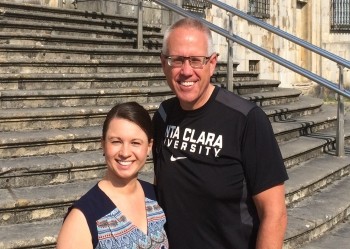
Jessie Graf, Assistant Director for Residential Ministry, Boston College
Steve Titus, President, Iowa Wesleyan University
DAY 2: JUNE 21 YOUNG IGNATIUS
Loyola and Azpeitia
Today we walked into and through Iñigo’s home. The journey provided an opportunity to reflect on what Iñigo was born into. What caught our eye before even going into the house was its apparent reconstruction; an apt metaphor for what happens when the grace of conversion enters and builds upon the foundation of our life’s narrative.
Standing in the room of Iñigo’s birth was an opportunity to imagine what it would have been like to be born in that space. Born the youngest child of 13 into a culture that valued honor and heroic feats, Iñigo was immediately thrust into a strong current of successive losses, not least of which was the loss of his mother shortly after his birth. This lead to a difficult decision for his father—to send him away from home to grow up under the nurture of Maria de Garin, the wife of the local blacksmith, for the next seven years.
We never considered Iñigo homeless until we reflected on the series of traumas that punctuated his early life, and how these scripted his identity. Looking back at Loyola castle, did he wonder why he was separated from his family? And at age seven, when he was called back to Loyola castle, what might it have been like for him to readjust to life within those walls? Then, what might have stirred within him when at the age of thirteen, his father died, and he was sent to apprentice with Juan Valasquez, the CFO for the Spanish crown? Young Iñigo was no stranger to life’s traumas, which together with his blessings, formed the foundation of his identity. Who would have thought that a cannonball would be the threshold through which Christ would rewrite Iñigo’s inherited narrative?
It is not lost on us that just a floor above where he was born, in his room, grace was mediated through his convalescence. What happens when such grace enters into one’s inherited narrative? Given what we know of our Ignatian inheritance, the effects of grace are as numerous as the stars in the night sky. As grace began to rewrite his narrative, Iñigo responded to what such grace invited him to become. Just as new brick was laid upon the foundation of his home, Iñigo’s new identity in Christ brought him to his true home; such is what happens when one falls in love with God.
So it was fitting we gathered for liturgy on the feast of St. Aloysius of Gonzaga, in the Chapel of Conversion, to celebrate the power and presence of the grace of conversion operative in human experience.
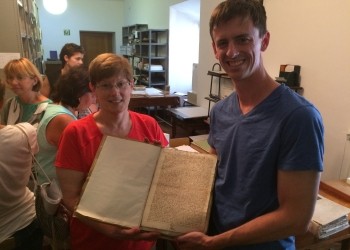
Brian Gilmore, Campus Minister and theology teacher, St. Louis University High School
Damian Zynda, Director of Ignatian Identity, McQuaid Jesuit
DAY 3: JUNE 22 MOMENTS OF CONVERSION
Loyola, Aranzazu, Pamplona, Javier
As individuals on the third day of a pilgrimage that is intentionally communal in nature, today, we awakened more deeply to the notion of personal transformation. Through our visits today to San Sebastián, Olatz, Aránzazu, and Pamplona, we have come to realize that it is because of Ignatius’ life experience that the Jesuit charism holds personal transformation, and personal encounter with God, as being so central to the development of an active and effective spiritual life.
That is to say that, essentially, were it not for the experiences of Ignatius that we mirrored on our journey today, the centrality of personal reflection and transformation to the Jesuit charism, and the myriad practices we as Jesuit educators take for granted today, simply would not exist.
Pretty cool stuff.
We tend to talk about Ignatius’ process of personal transformation in terms of disparate events, using lots of words that don’t always seem like the same thing. We talk about his adolescence, baptism, relocation, injury, healing, conversion, confession, meditation, reflection, pilgrimage, change of plans, service of community, and leadership. Really, though, each of these events (or processes) is talking about the same thing: intentional, God-driven change for the better.
One of the topics that has arisen several times for us in discussion is the idea that, in order for God to work positive transformation in our lives, we need to create the time necessary for that transformation to occur, and/or, we need to have God thrust that time upon us, whether we like it or not.
We began our day at the parish of San Sebastián in Azpeitia, where Ignatius was baptized, and as Stephen Kramer so eloquently shared today, where the Ignatius of the past died a spiritual death, and was reborn, now completely focused on the exigencies of Christian baptism. Our visit reminds us not only that Ignatius, though now a saint, was truly imperfect as we are, but that in Christian baptism, we are gifted with the promise that our imperfection does not preclude us from salvation. In giving up our former weakness as Ignatius did (again stealing Stephen’s words), we choose the path that leads to (and is empowered by) God.
We continued with Mass at the hermitage of Olatz, where Ignatius stopped before heading on his way to Montserrat. Inside the thirteenth century chapel, we were reminded of the importance of Our Lady for pilgrims from the Basque country during Ignatius’ time. In his homily, Father Casey invoked Mary’s accompaniment for the remaining stages of our pilgrimage, further deepening the connection between Ignatius’ personal experience and the personalized transformations we are each continually undergoing.
Departing from Azpeitia as Ignatius did—though by luxury coach instead of on foot—we climbed [rode] winding roads and reached the cliffside sanctuary of Aránzazu just before noon. Designed in a rather modern style, the church brought us a true sense of wonder and comfort, especially for those of us who were unsettled by the switchbacks of Aránzazu’s mountain roads. The column-free stone nave of the sanctuary culminated in a towering rock mural behind the altar, and was illuminated in blue from either side by two opposing stained glass windows. The entire space evoked the silent awe of entering a grand, holy cavern.
This design is appropriate for several reasons, not least of which is the resultant personal experience that the structure allows for visitors. Not only does the gaping interior subtly reference Ignatius’ later experience in the cave at Manresa, but it also echoes (and seamlessly nestles into) the surrounding landscape of hawthorn plants and limestone cliffs, allowing the mind and heart to effortlessly connect nature—creation—with God, as Ignatius was so wont to do.
Finally, we must address the reason for the sanctuary’s existence in the first place: Ignatius’ all-night vigil to the icon of Mary (which we saw up close!). Not only does this vigil demonstrate for us Ignatius’ intense devotion to Our Lady as he set out on his pilgrimage—on a grander scale of character, it epitomizes the above-and-beyond approach that Ignatius chose in living out his dedication to all aspects of his faith. The epic space and scale of the Aránzazu sanctuary, then, allows us as individual pilgrims more profound access to comprehension and pursuit of the same level of devotion.
Finally, we made our way to Pamplona, our final stop in the Basque country, and the site of Ignatius’ injury by cannonball. We considered yesterday the utility of Ignatius’ suffering (and perhaps suffering in general) as a means to allow time and space for God to speak to us. Today, remembering Ignatius’ reflection and healing at the chapel of the conversion, we were able to contemplate the benefits of suffering—humility, gratitude, reflection—more completely, as we visited the exact location of Ignatius’ injury that left him bed-ridden in the first place.
This injury was, of course, not in Ignatius’ master plan for his life, but we are reassured in looking back at his life’s trajectory that were it not for this injury, the Jesuit order would likely not exist, and we each as individuals would not have been formed by the charism that resulted from Ignatius’ injury. For those of us whose life plans have drastically changed due to circumstances outside of our control, this is a rather comforting piece of knowledge to encounter.
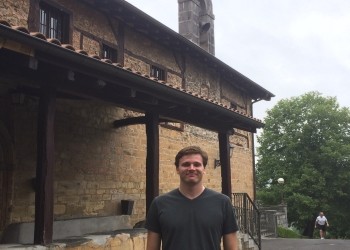
Peter Baxter, College Counselor, Jesuit High School, Tampa FL.
DAY 4: JUNE 23 PILGRIMAGE AND DISCERNMENT
Zaragoza, Verdú, Montserrat
Today we encountered two famous Jesuits, from close but separate eras who each had relationships with ‘the other’ and the marginalized in ways that inspire some and have others grappling with our place in the world.
We began the Feast of the Sacred Heart in the basilica adjacent to the Xavier Castle, where Francis Xavier grew up. After a warm sleep, the cool breeze at breakfast and on the walk to the castle were rejuvenating. Fr. Casey’s homily reminded us of the Sacred Heart of Jesus as it appeared on the altar at San Sebastian in Azpeitia--exposed, vulnerable and real. We encountered the body in other real ways this day. As we walked through the chapel, our gaze soon turned from the heart to the face of Christ.
Within the castle, the Smiling Christ is enclosed in a chapel surrounded by portrayals of The Pest. This depiction of Christ was created with a face of kindness to counter a plague in the area, perhaps in the 13th century. It was before this Smiling Christ that a young Xavier prayed. Both the view from above and the view from its intended entryway, that face, the kindness of it and the contentedness of its countenance struck some pilgrims in our own hearts. There was also an image of Christ as portrayed in Japan on Xavier’s travels with visual similarities to the people that Francis served. Many pilgrims remarked that this relationship Francis and later Peter Claver had in the mission work compels us to grapple with those similar relationships in the world today.
We traveled from the castle back towards the path of Ignatius would have taken on his own pilgrimage from his home to Montserrat, we spent time looking at the same views, the same hills, the same crops that Ignatius would have knew and saw. Our stop at the Lady of the Pillar in Zaragoza gave us pause to touch the pillar which has been kissed and venerated since the second century when James the Greater received it in the Ebro river. The hallowed space that has been created by all the human touch was a reminder, perhaps complicated between the head and the heart, of the importance of the physical to our approach to the metaphysical.
On our ride on the bus after a well-enjoyed lunch with great company and food and exploration, we were invited to consider how we as pilgrims we are grappling with our place in the world and where our faith calls us. The readings for the day (largely letters written by Ignatius) focused on discernment, fitting given the thoughts we had of connecting the physical and metaphysical. Presentations considered how intentional decisions had to be for discernment to play a part. We were also asked to consider the relationship between the open heart of Jesus, in juxtaposition with the open heart of discernment that Ignatius described in one reading for today. And we read selections from the same knightly tale that so tempted Ignatius, the Pilgrim, as he traveled this same area towards Montserrat, and we imagined how he struggled to discern the meaning and direction of his journey and how he would have found encouragement and sustenance from traveling this well-worn pilgrims’ trail and venerating Our Lady, in Aranzazu, Zaragoza, and soon Montserrat.
Before we reached Montserrat, our stop in Verdu provided great surprise and a continued encounter of the dynamic between the body and our faith. The birthplace of St. Peter Claver (born in 1580 but not canonized until 1888) now houses a lovely chapel, a hostel for pilgrims (we were given and extensive tour) on the Ignatian Way. It also houses the relic of Claver in the form of one of his ribs. We took our photo there.
We arrived in Montserrat to an amazing dinner, picture perfect views and a celebration of the vigil of St. John the Baptist which included a bonfire, singing, dancing, fireworks, cake, brandy, and a long walk at midnight.
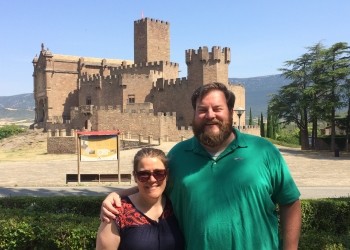
Kim Smith, Vice Principal for Curriculum and Professional Development, Boston College High School, Dorchester, Massachusetts
Paul Muller, Director of Admissions, Regis Jesuit High School, Denver, Colorado
DAY 5: JUNE 24 SPIRITUAL DEVELOPMENT
Montserrat, Manresa
Reflection I: Karen Smith
The bells of the Benedictine monastery peal matin hours and serve as our wake up call this morning. A light fog hung over the mountains give an almost ethereal feel to our surroundings. It is here, in Montserrat, where Ignatius gave his general confession, let go of his sword and began his new life as pilgrim, dedicated to God alone. We had the advantage of arriving by bus, but Ignatius would have arrived on foot, a perilous and tiring climb. For him, this was a perfect place to pause and reflect during his journey. For us, it is the same.
We celebrated liturgy in a small chapel tucked behind the main altar of the basilica. From our vantage point we can see the back of Our Lady of Montserrat, at whose feet Ignatius laid his sword and took up the staff of the pilgrim. We would soon join in the line of men and women waiting to venerate her.
As we emerged from the chapel, the sun shone bright and the fog had lifted. Our day was ours for exploration and many small groups took to the hills to hike and explore and pray. At this point in his journey, Ignatius would have been so alone on his journey, but we have been finding God in and among the companionship of our fellow travelers.
We reconvened in the late afternoon to make our way to Manresa, where we will visit the sites of some of Ignatius’s greatest ecstasies and deepest sorrows.
Reflection II: Mark Ladd
From Javier, we have traveled two hours into the Montserrat mountain range. When we reached the top, all I had to do was look around to understand the perspective Ignatius had while he was here. This place allows you to see the world “with the eyes of God”. Ignatian spirituality encourages seeing “God in all things”. I have been reflecting on why Ignatius has named his order the Company of Jesus. From my reflections, I believe Ignatius wants us to always be in companionship with Jesus in many ways. This allows us to see God in all things and the Jesuits continue to carry on this message through their many vocations. For me, Montserrat was the first place Ignatius started to view the world in this way.
I have noticed the union of Jesus and my surroundings. This pilgrimage has truly tested our endurance and spirituality. We have been moving from place to place throughout the days making the day seem longer and my body feel tired. Then I realized during our drive to Montserrat that Ignatius walked this journey. I am able to see these places of Ignatius’ life and conversion in a matter of hours and he spent months walking with the struggle of his own humanity. Ignatius carried his cross a long way to Montserrat. This would be the perfect place to pause and reflect during his journey.
Each day we have started with Mass. This in itself has brought me closer to Jesus through the celebration of the Eucharist. It is a constant reminder that God is present with me at this very moment. This is especially important to me because we have gone to Mass in a different chapel in a different city every day for the past four days. No matter where we go or where we are, we can always find time for God.
Everywhere we have traveled offer its own beauty. Ignatius’ hometown was in a valley surrounded by mountains. Zaragoza’s basilica was amazing to see the capabilities of man through architecture all for the purpose to glorify God. Javier provided a stunning view of an old castle in the countryside which Francis Xavier would have experienced while growing up. Montserrat is also naturally breathtaking. We stayed at the top near the Benedictine monastery. This pinnacle gave me “God’s view”. I could see the surrounding area of Catalonia but I now understood that maybe Ignatius could see God’s plan. It was at the top of Montserrat where Ignatius started to realize there is a greater purpose to his journey.
These all having put me in the company of Jesus. I find God through the presence, conversations, and bonds with the people around me. This is the most important place for me to meet God. Ignatius would have been so alone at this point of his journey and he finally reaches Montserrat where he is able to confide in a Benedictine priest. I think we all seek help companionship in some way. In this moment, Ignatius needed spiritual companionship before he was able to be in companionship with others. I have come to learn this is what I need to do in my own life. I need to take time for myself to reflect and find God so I can be a better companion to those around me.
Ignatius’ journey has given me insight to how he might have personally found God and why he wants us to always be in company with Jesus. Through the pilgrimage, mass, the different sights, and our relationships with ourselves and others, I have come to see why Montserrat was the spiritual birthplace for Ignatius. It was at this very place where he would have been able to stop, look around, and find time for his own spirituality. Maybe this mountain top pushed Ignatius to the edge of his past life and allowed him to lay down his sword so he could be with God.
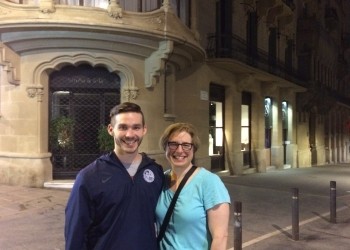
Karen Smith, School of Theology and Minestry, Boston College
Mark Ladd, Theology teacher, Arrupe Jesuit High School
DAY 6: JUNE 25 A LIVING EXAMPLE IN MANRESA
Manresa
“Lord, in your great love, answer me.” This refrain from today’s psalm illuminates the tension between light and darkness that St. Ignatius of Loyola experienced during his eleven month stay in Manresa. The psalmist, in desperation, yearns for God’s mercy through a response. After surrendering his sword to Our Lady of Montserrat, Ignatius voluntarily invites the death of his chivalrous life. As Ignatius descends toward Manresa, he adorns himself with a new armor of humility as a pilgrim. Through experimentation with prayer and encounters with the people of Manresa, Ignatius desires to hear a response from God. While Ignatius freely accepts this transition from knight to pilgrim, it is not without conflict. As our group heard from Fr. Louis, former Provincial of the Spanish province and Director of the Jesuit Centre for Spirituality, Manresa is a place of extremes. The transition from winter to summer is dramatic in this area, and the contrast between the river and surrounding cliffs is striking. The tensions between old and new, local and foreign, sacred and profane present in contemporary Manresa help us to better understand the physical and spiritual interruptions that stirred Ignatius in this sacred landscape. God, in his mercy, invites Ignatius into a transformation of body, mind, and spirit as a pilgrim.
Our day began with mass in the holy cave which Ignatius took on the life of an aesthetic pilgrim. As mentioned in our group’s introduction to Manresa, this “stopping place” became a “founding place” for Ignatius. Where Ignatius’s life was interrupted by his injuries sustained fighting in Pamplona, he accepts God’s invitation to become a pilgrim. In this cave, Ignatius began experimenting with his prayer practices and crafting the Spiritual Exercises. The right wall of the cave reflects the original stone with its two hand-carved crosses still present. This stone wall shows the simple humility Ignatius was seeking in his relationship with God. The opposite wall of the cave, adorned with ornate marble, stands in stark contrast to his desired simplicity. As we prayed together in this space, our group could not help but feel the palpable disruption of Ignatius’s life of pride and riches, and his invitation to accept a simple piety.
Departing the cave, we traveled to the Well of the Illumination. This contemporary installation sits on the location where God graced Ignatius will a new understanding that God was in all things. From this vantage point, we took in what would have been Ignatius’s view of Manresa. This panoramic landscape includes the life he left behind at Montserrat, the majestic Cardoner river, Ignatius’s holy cave, and the prominent Basilica of Our Lady of Santa Maria at the center of this view. Here, Ignatius believed that God interrupted his life one more time, illuminated him to see the world in an entirely new way.
Throughout his eleven month stay in Manresa, God continued to interrupt Ignatius’s life and invite him to deeper understandings of his spiritual transformation. After his illumination, it was reported that Ignatius spent eight days in spiritual ecstasy. This important event, depicted in the Chapel of the Rapture in the Hospital were Ignatius once lived and served, helped build the case for St. Ignatius’s canonization. Later on in the Day, we visited the Basilica of Santa Maria de Manresa where Ignatius prayed and begged during his time here. This church was a source of stability in Ignatius’s life during this time of transformation. The massive structure interrupts the pristine landscape, while continuing to provide a strong foundation of faith within the community.
Our day ended with a conversation with Fr. Louis, the director of the retreat center, about the Jesuit’s evolving mission within Manresa and Spain. The mission of the retreat center is to balance the important tension between old in new as it is charged with upholding the sacred sites of St. Ignatius’s life, but also adapt to meet the needs of a contemporary Church. The Spiritual Exercises, developed and transcribed in this place, continue to infuse this center’s way of proceeding in its formation of clergy and laity. After our lecture, we crossed town one more time for our final meal in Manresa. With Ramadan coming to an end, the growing Moroccan community in Manresa filled the streets where Ignatius once walked. This was a consoling reminder of God’s ever-evolving and transformational work within this community.
Manresa continues to be a place of dualities, tension, and change. In experiencing this place through the eyes of Ignatius, we can see that each of God’s interruptions serve as invitations into greater love and growth. Both in darkness and in light, Ignatius’s time in Manresa marks an important transformation in his spiritual life and relationship with God. As our group continues on pilgrimage, we continue to embrace the tensions and interruptions within our own lives, and are more acutely aware of the invitations that God calls us toward in our collaborating with the Society of Jesus.
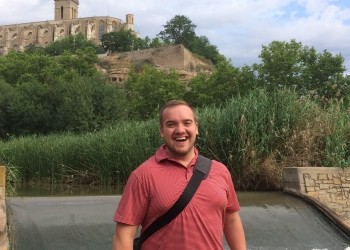
Benjamin Horgan, Loyola Blakefield, Baltimore, Maryland
DAY 7: JUNE 26 ENCOUNTERING THE WORLD IN BARCELONA
Barcelona
Today’s theme, namely “encounter” and “world” very much guides this reflection. Following in our Pilgrim’s footsteps, his spiritual development in Montserrat and Manresa, we are brought to Barcelona due to St. Ignatius desire to travel to the Holy Land. As we arrive, immediately apparent becomes the openness and cosmopolitan spirit of this city, which stands in contrast to the mountains and caves of Montserrat and Manresa.
We learn from our guide that most likely Ignatius has spent time in Barcelona prior to his conversion. After his conversion, Ignatius had two important visits significant for what was to come. First, Ignatius brief visit in 1523 before parting for the continuation of his pilgrimage to the Holy Land and the second, his longer stay from 1524 to 1526, when he dedicated his attention to formal education.
Following Ignatius pilgrimage Barcelona signifies an opening of mind, heart and soul. Up until now Iñigo has moved in a relatively small circle of encounter. He speaks his Basque dialect and understands other dialects spoken throughout the North of Spain, but has no Latin and no Italian, as he is recommended a translator for his travels. Ignatius is determined to face the risky journey to the Holy Land via Rome as a lone pilgrim, completely relying the mercy of God. Initially he even refused to bring a sufficient amount of bread for the journey on board, but when the captain denies him passage, he went out to beg for the minimum amount of the required provision. His complete faith in God seemed confirmed when the vessel he originally intended to board sinks off the coast of Catalonia.
As Casey Beaumier said: “Distance gives clarity”. Hence, in 1526 Saint Ignatius returns from the Holy Land more open to the world and chastened, aware that he lacks an academic education. It is through Ignatius’ own story that I take inspiration for my own life and my work in the Society. The Society’s tradition roots us, provides the foundation upon we then can built in an creative and organic manner, responding to the needs of our time and future-proofing our mission. When meeting with JECSE (Jesuit European Committee for Primary and Secondary Education) once per annum, I always gain a lot of understanding, insights and inspiration from my Catalan colleagues who master the above written (and hearing Fr. Louis in Manresa speaking on Sunday those thoughts were confirmed): being sure of their heritage and rooted in tradition, they step forward bringing Catalan education in the spirit of Ignatius into the 21st century in the most creative, holistic, connected and visionary manner. They simply see the bigger picture!
When arriving in Barcelona, we first prayed at the Jesuit church of the Sagrat Cor, where the sword Ignatius left at Montserrat after general confession is displayed. After lunch we visited Santa Maria del Mar and La Sagrada Famiglia, two breathtakingly beautiful churches that made me reflect on the themes of tradition and modernity, medieval versus contemporary spirituality. And again, Spain, the cradle of the Society, represents the rock solid foundation upon Ignatius, his companions and many generations of dedicated Jesuits built upon. I was deeply moved by Antoni Gaudi’s genius vision for La Sagrada Familia. Gaudi was a devout Catholic, humble and genius, with an acute sense for social justice, as I discovered sitting in the little, most beautiful yet functional school he built from his own limited funds right next to the church. Walking through La Sagrada Familia, Gaudi teaches me one very important lesson, namely that perfection lies in nature, in God’s original creation. Gaudi observed nature, which is not significant in itself, but he had the genius to understand nature, its mathematical and geometrical perfection, learn from it and translate it into architecture and design. By adding his overflowing creativity he created a basilica that is unique in every aspect (even every angle). Despite his genius Antoni Gaudi never fails to honour the greatness of nature (of God) over the achievements of human kind, as he designs the towers to be lower than the surrounding hills. La Sagrada Familia is built on the foundations of a design of a more traditional church, as we saw and experienced when celebrating Mass in the crypt. The regular, traditional design of the crypt represents the roots of our faith for me. From the ground beautiful pillars, resembling tree stems rise up and guide our focus upwards, to the heavens, towards all that is, namely God. While growing upwards the tree branches out, becomes diverse. La Sagrada Familia for me represents the evolution of our faith and leaves me with an important lesson: when our roots are firm and we move towards the heavens (all that is good and all that is light), we do not have to be afraid of change, but embrace it.
Elisabeth Clarke, Gonzaga College, SJ, Dublin, Ireland
DAY 8: JUNE 27 THE FOUNDATION OF THE SOCIETY
Rome
Following a week together in Spain as pilgrims, we have arrived in Rome ready to experience the historical places and moments of the establishment of the Society of Jesus. This has been a day of change: from Spain to Italy, from the molding of Ignatius’ heart to the molding of his mind, from anticipation to actualization. The stops on today’s portion of our pilgrimage allowed us to contemplate the changes –minor and major- that define a life, a movement, and a community of believers.
Through questioning and reflection, we can delve deeper into our subconscious. On the way to a small pink chapel at La Storta the group was asked to privately contemplate what ‘hunger or yearning has brought us to this point’. This was a perfect juncture for this particular question as the church at La Storta was where Ignatius had a vision of Jesus saying “I will be propitious to you in Rome”. It felt as if Ignatius received confirmation that he was on the correct path, a path that quickly grew into something more fruitful. The question posed to us entwined perfectly with this as we can reflect on our own aims and intentions as we move forward on our personal and spiritual journey. This church had an effect on all members of group in many different ways. Whether it was the modest nature of the space (in stark contrast to what we have become used to), the dove on the roof, the virgin Mary holding her child with outstretched arms, it certainly reached out to each of us. We have established a pattern of pausing for five minutes of prayer and reflection at many of the stops along the way, which give us time to organize some of these thoughts.
Transition has been evident in other areas of the trip as well. At Santa Maria Maggiore, we celebrated Mass in the chapel where Ignatius celebrated his first Mass, roughly a year after his ordination. We were told that saying mass took a huge amount out of Ignatius, both mentally and physically. He would often shake and sweat before service as he felt he must do justice to Jesus and our Lord with every word he spoke. Ignatius encouraged his companions to seek nourishment in the Eucharist. For our group, daily Mass has been a blessing. The opportunity to profess faith in such meaningful settings is strengthening the bonds that we have been forming as a group. On our first Mass together, the sign of peace consisted of a handshake. Observing this exchange at Santa Maria Maggiore today, people are reaching across aisles for a full embrace. The closeness of the group is palpable as we begin our stay in Rome, the final destination of the pilgrimage.
Today we also had the opportunity to visit St. Paul’s Outside the Wall. Here, we paused to consider the evolution in Ignatius’ interior movements and that of the Society of Jesus as an Order. In Ignatius’ early years in Rome, the Society grew quickly while seeking to maintain the quality of formation and service. Documents published by the Society in 1540 and 1550 show subtle shifts in the understanding the Society is gaining of its mission. In this way, our group is making subtle shifts: conversations no longer must rest in the trivial details of our lives but are able to penetrate to more meaningful events and feelings. Like the Society of Jesus in its early years, the next few weeks of study that remain for us feel “pregnant with opportunity” to discover and implement the lessons of the leadership of the Society of Jesus.
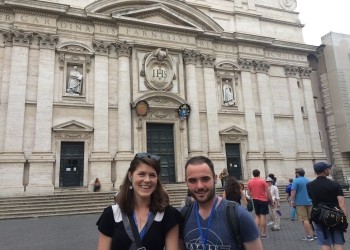
Katie McKiernan, Boston College High School, Dorchester, Massachusetts
Rob Quinlan Gonzaga College, SJ, Dublin, Ireland
DAY 9: JUNE 28TH THE EARLY GOVERNANCE OF THE SOCIETY
Rome
“Being overwhelmed is a beautiful reality.” - Fr. Casey reminded us at today’s mass, which we celebrated in the room where St. Ignatius died. He continued to explain that we can also feel a sense of gratitude in being overwhelmed. We chose to reflect on those concepts throughout the day. Specifically, we tried to reflect on the question: How can we experience gratitude and beauty in our feelings of being overwhelmed?
Spaces:
Today we felt and understood the importance and power of space. While experiencing the gravity and importance of the spaces we visited could be overwhelming, we felt incredible gratitude for the connectedness that the spaces of the day brought to us. Spaces allow us to feel memories of our past and also allow future memories to be better informed by past spaces. Spaces bring to life the people that lived before us and their experiences in the world. We visited several sacred spaces throughout the early part of the day that allowed us to us to remember and revere people:
Our tour guide, Daniella, pointed out that St Catherine of Siena (patroness of Italy and the US) is buried near our hotel beneath the high altar of Santa Maria sopra Minerva. St Catherine would be the first of many great saints we would encounter today, and with her help we would be drawn further into the great spaces of Roma. Just a few steps down the road our breath was taken by the Pantheon. As the raindrops fell on us, we stood beneath the oculus in awe at this amazing example of human creativity and engineering.
The Church of the Gesù, the Jesuits Mother Church, is an inspiring, beautiful Church that houses remains of St. Ignatius, St. Xavier, and Pedro Arrupe (the 28th General of the Society of Jesus). It was moving and humbling to see the places where these great men rest and to reflect on the lives they led and the progress they made for the Society.
After visiting the Gesu, we walked to the rooms of St. Ignatius. Simple rooms housed in a nondescript building included many vivid remnants of Ignatius’s life, including his shoes, a frock, and a book. We celebrated mass in the room where he died - indeed an overwhelming, yet beautiful experience.
People:
Many of us on the trip have remarked on the gratitude we have for those who have made this trip possible for us - benefactors at our home institutions, our classmates on the trip, our families, and our colleagues at work. Today we felt also the gratitude in having three Jesuits in our company. We are fortunate to experience such sacred places such as the Church of the Gesù or St. Ignatius’s home and place of death, with these who have devoted their lives to the Society of Jesus. We recognize the significance and importance they may feel visiting these places, deepening the overall experience for many.
Our walking tour of sacred Jesuit spaces was enlivened with two wonderful Jesuit interactions: Fr. Maher, speaking to us about his research at the Gesu; followed by a visit to the Jesuit Curia, where we met with Fr. Jessie. Both men shared their insights with us: Fr Maher speaking to us about his discovered history of the Gesu; and Fr. Jessie sharing his experiences and thoughts about the Curia, the current state of the Jesuits, the structure of the Society, and what he feels the future holds for the Society.
The evening was capped by a wonderful dinner with special guests from Rome, including the editor of the Curia’s journals and the Secretary of the Society. We continued to be overwhelmed by, and deeply appreciative of, the spaces that we encounter which allow us to share reflections with our colleagues, engage in meaningful conversation and explore the history and future of the Society of Jesus.
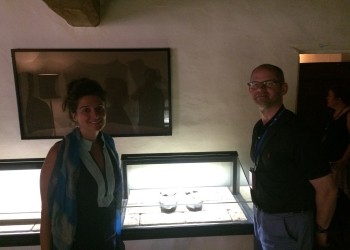
Steve Rabatin, Architect, Rochester, Minnesota
Claudia Pouravelis, Boston College, Chestnut Hill, Massachusetts
DAY 10: JUNE 29 YOUNG JESUITS IN ROME
Rome
Pallium Mass
Our eager group started out early to secure good seats for a Papal Mass in St. Peter’s Square. We were met with a merciful break from the typical Roman heat for what turned out to be a beautiful morning and an even more beautiful Pallium Mass, wherein newly elevated Bishops and Cardinals received the lamb’s wool stole that symbolizes their roles as shepherds of the Church. The group lingered after Mass and were rewarded with some great photo opportunities as the Holy Father passed directly by: Lar Duffy insists the Pope waved to him personally. After our drive-by “Papal audience,” the group split to sightsee and enjoy lunch in the bustling streets surrounding the Vatican.
Sant’Ignazio Church
Later in the afternoon we reunited to visit Sant’Ignazio Church, which was built as a Chapel for the original Collegio Romano and was dedicated to Ignatius. Within it we were astounded by the beauty of another one of Br. Andrea Pozzo’s works of art. A master of perspective, he painted a ceiling that gives the eyes as well as the heart a image of the heavens.
Also at Sant’Ignazio, we encountered the relics and altars of Jan Berchmans and Aloysius Gonzaga, two of the Jesuit’s “boy” saints. Both were beautiful reminders and votives to lives poured out for the love of God. Their brief stories are moving inspirations towards virtue and proof that God’s grace is accessible to all, even to the youngest and simplest of people.
Jesuit Novitiate and the Church of Sant'Andrea
From there we moved to the old Jesuit Novitiate and the Church of Sant'Andrea, which Berini built as a chapel for the novices. The Novitiate housed not only Ignatius at times but was the final home to another saint, Stanislaw Kostka. Kostka, another “boy” saint of the Society, continues to inspire admiration and devotion as he did in his own time. We were moved by the artwork outside of his room depicting the great suffering he underwent throughout his short life, whether at the hands of his family trying to prevent him from entering the Jesuits or the physical illness that plagued him until his death.
The Church, which was begun but not completed by the time of Kostka’s death, was considered by Bernini to be the best of his work. The baroque Church is dedicated to St. Andrew in not only its name, but also in its construction. It is a strange oval space that places the main altar along one of the longer walls, giving it a noticeably short nave. This building itself, therefore, recalls the suffering and martyrdom of St. Andrew who was crucified on a diagonal x-shaped cross rather than the upright t-shape of Christ’s cross. It seemed a fitting Church for its proximity to Kostka’s life and story.
The remainder of the day was free for all to have dinner and to further explore Rome. Of course, with all of the holy stories and beauty that we encountered, as well as with all of the walking around, rest and reflection were high on many people’s agenda.
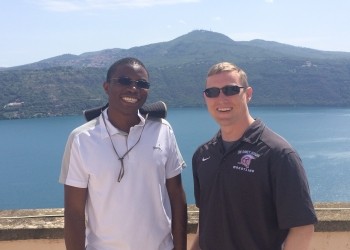
Evarist Shigi S.J., Student, Boston College School of Theology and Ministry
Stephen Kramer S.J., Student, Boston College School of Theology and Ministry
DAY 11: THE IGNATIAN LEGACY
Rome
How to end your travels with an exclamation mark.
Oh Lord my God
When I in awesome wonder
Consider all the works Thy hands have made…
Throughout this trip we’ve found ourselves looking up at things, whether it’s the majestic roof of the cathedral at Manresa, the trompe d’oeil of the Ignazio, or the stars above Montserrat as the fireworks of the Feast of St. John the Baptist explode in the Catalan night below. The fusion of Nature with man’s curiosity has long been a source for science, letters, and art, so it should come as no surprise that we spend our last full day in Rome still either looking up at things, looking deeply into things, looking down from the roofs of things, or just looking things up.
We had seen in the Segrada Da Familia the respect for the symbolic height of the power of God - a deliberate attempt to build the cathedral so this man made-made structure would be just slightly less than the height of the tallest formation in the natural surrounding world. This is science and art as devotion, reminding us of the inscription from the statue outside the church of Santa Maria supra Minerva in Roma: ‘only a robust mind can carry the weight of divine wisdom’. There were some pretty robust minds on show today, but they all lead us to the same conclusion.
We looked at the expansion from dealing with just the religious aspect of the society to those areas that are extensions or connections in the arts and sciences. This began with Castel Gandolfo, where we saw the Jesuit observatory and learned of how much the Order has contributed to the history of astronomy and astrophysics. Paul Mueller, SJ, Provincial of the community, noted that there are six Jesuits with at least a PhD in Physics working in the Observatory system, here and in Mount Graham Arizona, where the latest telescopes are located.
We found it amazingly heartening to see such commitment to science, and even more amazing that such support has been consistent across the many Popes who have ruled since the foundation of the observatory under Gregory XIII. Funny to think that Clavius was in regular correspondence with Kepler, or that the maps of the stars recorded over 140 years ago are still vital to the development of astronomy. This marriage of faith and reason, the embrace of science by the Society, inspires because it reflects how the Jesuits like to look beyond. It brought to mind Ronald Reagan’s eulogy at the funeral service for the Challenger astronauts, where he quoted John Gillespie McGee: we see how man “slipped the surly bounds of the earth… touched the face of God”.
The change from looking at just Ignatius to looking at how the Jesuits began to look out from themselves and connect with the world—not just during the formative years of the society but continuing and expanding as the years have gone on—has been a major thesis in this trip; here we see such undeniable evidence of curiosity and intellectual rigour as to make this point self-evident.
A quick stop to the stunning Bernini church of San Tommaso da Villanova in the town square, before heading back to the Jesuit Curia in Vatican city. We’d been there on Wednesday, finding out about operations and looking out from the roof garden, smelling the fresh rosemary and marvelling at the architecture laid out before us. But today we got to look deeply into the treasure trove of the Jesuit Archive. And treasure we saw, thanks to our friend Rev. Brian Mac Cuarta, who was generous with his time and as enthralled with the material he showed us as we were to see it for the first time. Here we could see more of this outward-looking Society, one which expanded and reported back, providing not just the General but posterity, with valuable documentation on a wide range of science, geography, botany, biology and anthropology.
It was amazing to think of the range of documentation here: an especial treat was seeing original documents from the early Jesuits, including material in the hand of Ignatius, Xavier and Claver. A particularly enlightening observation in the context of the relationship between the Vatican and the Jesuits can be made—with such an extensive network of correspondence between the missions and the General, the information provided was frequently much more up to date and pertinent than the information used when the Pope instructed on such priorities. Armed with more information, the Jesuits could act in perhaps more directed ways, which must have been difficult for relations with the Vatican at times. Nowadays, societies where documents and reports have been suppressed or destroyed can return to the archives in the Curia in much the same way as modern astronomers return to Castel Gandolfo to see material they can trust, to put the present in context of the past.
At the day’s end we snuck in a little art appreciation, with three Caravaggios in the church of San Luigi dei Francesi and a quick wonder at Michaelangeo’s Christ the Redeemer in the church of Santa Maria sopra Minerva. We returned home, remarking on how some of the finest art is devotional, but also how devotion can be brought to bear in science and letters, too. All of this work points towards the majesty of God’s creation and can still seize the senses and haul our eyelids up, giving us utility, consolation or even just joy. It left us with a commonly held expression of devotion ourselves:
My God! How great Thou art!
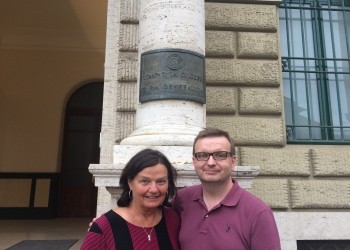
Lar Duffy, English teacher, Gonzaga College, SJ, Dublin, Ireland
Sheila Fisher, Physics teacher, Boston College High School, Dorchester, Massachusetts


